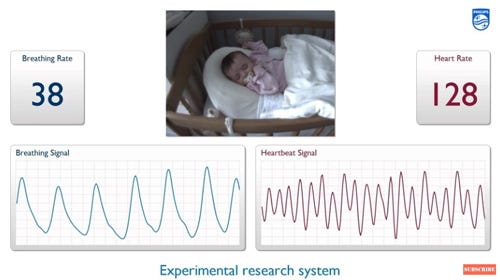September 13, 2016
The new medical device accurately measures absolute oxygen saturation of arterial blood using a camera-based monitoring technology that quantifies tiny changes in skin color.
Kristopher Sturgis

Researchers from Royal Philips have published a new study detailing a contactless monitoring device that can detect tiny changes in skin color to measure blood oxygenation levels (SpO?), a vital sign that is commonly monitored in patients. The device was designed to use a proprietary camera-based technology that measures light reflecting off of the forehead of patients to calculate SpO? levels.
Philips, an industry leader in patient care and monitoring technologies, has become the first to develop a contactless SpO? monitoring device that can be specifically calibrated to individual patients, providing accurate measurements without the need of constant adjustments or reconfiguring.
The device works with cardiovascular pressure waves that cause tiny blushes in the face with every heartbeat. While these micro-blushes aren't visible to the human eye, Philips' new monitoring algorithms can quantify these changes with their new camera technology, and calculate pulse rate and SpO? levels. The overall aim is to provide monitoring solutions that can accurately measure vital signs in a less intrusive way to avoid patient distress and improve overall patient care.
Philips has been a major player in the medtech realm recently, as the company looks to expand their presence with new health monitoring devices, apps, and cloud-based analytic programs. Earlier this year Philips announced the availability of a host of new health monitoring devices including a health watch, connected scale, blood pressure monitor, and thermometer. All of their devices have been designed to pair with their new HealhSuite health app, a cloud-based platform that can collect and analyze health data that is now available on iOS and Android.
Carla Kriwet, CEO of Philips patient care and monitoring solutions, said in the press release that contactless monitoring solutions can offer clinicians a way to accurately measure vital signs for patients who require less intrusive methods, while still providing them with the accurate data needed for quality patient care.
"Vital signs monitoring is crucial across all types of care settings," Kriwet said. "But for patient populations with specific conditions, managing their care in a less intrusive way is critical in order to avoid unnecessary distress."
One of the specific patient populations that could benefit the most from this technology could be premature infants in the NICU, where a contactless solution would help newborn infants avoid skin damage or other complications that arise from any kind of clunky technology anchored to their fragile bodies.
The technology is just one of several development from Philips this year, as the company continues to produce innovative medtech solutions that are more personalized and cost-effective. Last week the company announced the launch of a next-gen oncology-treatment system designed to analyze and target tumor lesions through minimally invasive treatment. Earlier this year the company also announced the development of a hand-held blood test device that can diagnose mild concussions--a device that could be a boon for doctors and researchers looking to curb brain injuries in sports.
As the company moves forward with their research, they hope to continue to enhance the device so that it can provide accurate health data through contactless monitoring. They even aim to improve the functionality so that it can monitor other key vital signs like heart and respiration rates. In time, the device could become the standard in contactless monitoring technologies and provide a baseline for innovative patient care solutions.
Kristopher Sturgis is a contributor to Qmed.
Like what you're reading? Subscribe to our daily e-newsletter.
[Image courtesy of Phlips]
About the Author(s)
You May Also Like


